Tim Egkan collected lost keys. Many of them he found lying discarded in the old downtown Stockton buildings owned by Ten Space, the development company he had moved from San Diego to help run. Hundreds of keys, says his widow, Katie Macrae. “He was like, ‘Well, you know, they open something,” she recalls softly, her British accent lilting upward as she sits curled on her sofa on a warm May afternoon, sipping tea.
Egkan was a man more fixated on the potential of things than their immediate utility. As Ten Space’s chief branding officer, he saw plenty of potential in Stockton’s beleaguered central core. Since 2000, the sprawling city’s overall population has risen while more central neighborhoods have lost up to 20 percent of their residents. And while some of these older neighborhoods have recently experienced a decreasing crime rate, the city is still considered by many to be one of the most dangerous in the U.S. In 2012, Stockton became the largest city in U.S. history to file for bankruptcy.
Egkan wanted to bring people back to the city’s largely-abandoned heart. One of his first projects upon settling in Stockton was the creation of a makeshift skate park in one of the warehouses owned by Ten Space. Taking to Facebook, Egkan reached out to Stockton’s skater community, inviting them to help disassemble a skate ramp he had built in Grass Valley, drive it back to Stockton and reassemble it in the warehouse.
Jeff Egkan, Tim Egkan’s father, recalls the tour his son gave him of the skate park: “I said, ‘Well Tim, what does this have to do with your commercial redevelopment project?’ and he said, ‘Oh, nothing now. It’s just part of trying to make this space more livable — there’s nothing for these kids to do.’ That was just something he thought they should have, so he did it.”
Jeff says his son showed a knack for business from a young age. When Egkan’s fourth-grade teacher advised him to bring in reading material to occupy him after he finished his work early (as he often did), Jeff says his son chose the business page from the L.A. Times. Egkan started his first business at age 14, selling car accessories online — when e-commerce was still relatively new — and eventually earning several hundred dollars a week, according to his father. Egkan would go on to teach himself about soil composition (he was a huge advocate of urban farming), coding and construction.
In 2012, Egkan met Zac Cort, the president and CEO of Ten Space. “Zac told him what he was doing in Stockton, and Tim got pretty excited about it,” Jeff says. “Tim didn’t know anything about commercial redevelopment, but he knew that — like he had done with anything — he could learn.”
“He really wanted to do urban ag, and that’s great for downtown,” Cort says, rattling off the reasons he recruited Egkan. “He knew more about the construction world than I did … He was young — he could take a risk and say, ‘OK, I’m going to come.’”
Tim Ekgan inside downtown Stockton’s historic Newberry building
in October 2014.
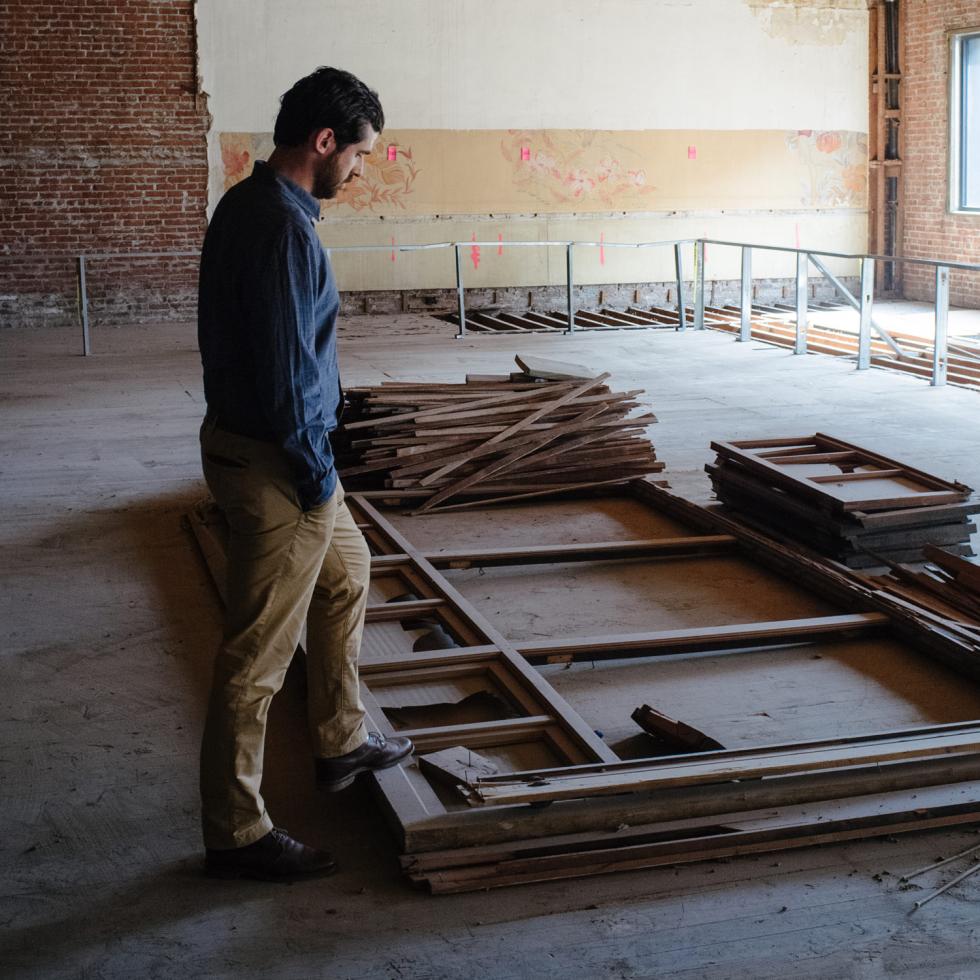
Egkan, who earned a bachelor’s degree in psychology from San Diego State University in 2005, served as Ten Space’s proverbial boots on the ground. He spent his days walking the streets of downtown Stockton, learning the landscape: He knew which doors held promise behind them, whether they be people or spaces, and he knew that one could unlock the other.
Take Huddle, for example, the 5,000-square-foot building on San Joaquin Street that would become Stockton’s first coworking space. Egkan spoke of his desire to lure entrepreneurs from coffee shops and home offices into the city’s core, saying they would “stimulate a new type of economy in Stockton.” Not only could Huddle offer a low-cost starting spot for fledgling entrepreneurs, those businesses might grow and need their own space downtown — and Ten Space had a line on plenty of spaces.
“I feel that there’s just an enormous opportunity to help shape this community by way of not just real estate development, but community and economic development as well,” Egkan said in August 2014. Friends and colleagues say he was involved in every step, from design to construction to recruiting tenants. A little over a year later, some of the same reclaimed wood Egkan selected for the building’s facade would be used to hold his ashes.
The circumstances around Egkan’s death remain elusive, with many of the facts either held back because of the ongoing police investigation or simply not known. What is known is that on the evening of Saturday, Sept. 12, 2015, he visited a few bars on the Miracle Mile — a stretch of Pacific Avenue and Harding Way — friends say to celebrate a downtown tour for Bay Area artists he had led earlier that day. At some point, late Saturday night or early Sunday morning, he was in an altercation, sustaining obvious signs of trauma, according to Officer Joe Silva, spokesman for the Stockton Police Department. The police have not revealed details of the altercation or who else was involved. They also have not connected the altercation to Egkan’s death. His death certificate lists cause of death as “stab wound of abdomen,” and estimates he died within minutes. He was 32 years old.
Egkan’s body was found roughly one mile from the Miracle Mile, less than three blocks from his home and within a block of Dameron Hospital. In the days and weeks following his death, there were marches and vigils; murals went up. Almost a year later, little more is known. No arrests have been made, the investigation is ongoing and police say they do not have a suspect. But the story that follows is not about Egkan’s final hours. It is about one room of his life — and the lives of those he inspired.
The Organizer
It’s April 2016, and Jasmine Leek sits in Huddle’s conference room at an industrial bright orange table that looks like it belongs on a spaceship. Instead of legs, metal bars stretch from a center point on the floor and angle upward to grip the table’s edges. There is a hub of electrical and USB outlets on the surface and at the base. Egkan invented this table. Leek, Huddle’s executive director at the time, is a little distracted, craning her neck as tenants drift past on their way in or out. Her face is round with a perpetually hopeful expression that she can’t shake, even when the conversation turns somber. Many people come and go over the next two hours. Some pop in and, when they realize Egkan is the topic of discussion, want to stay. Everyone has a Tim-story to tell — artists, activists, small business owners. A common theme emerges: “He was a mentor,” Leek says.
“He wanted people to see there is a standard, and Stockton needed to rise to the occasion … he wanted the best for Stockton and he wanted us to push ourselves.”Jasmine Leek, founder, Third City Coalition
She met Egkan when stopping by Trail Coffee Roasters, which connects to Huddle via a not-so-secret passageway. Gianna Vicari, owner of Trail and a friend of Leek’s, introduced her to Egkan and Macrae. “I just felt like, everything I have done in my life job-wise up until this point does not compare to what these people are doing,” says Leek, whose job in corporate staffing left her unfulfilled. At the time, she had started attending city council meetings and was working with the Reinvent South Stockton Coalition, but still felt a bit aimless. Until she met Egkan.
“Tim was very meticulous about the way things looked; he wanted to give people what they deserved in terms of design, quality and ownership of their product or brand,” Leek says. “He wanted people to see there is a standard, and Stockton needed to rise to the occasion. And he was unapologetic about it. That might have rubbed some people the wrong way, but he wanted the best for Stockton and he wanted us to push ourselves.”
Egkan and Macrae took Leek in and nurtured her aspirations. Macrae was looking to focus on a new project, an outdoor market dubbed Stockmarket, so Leek took over Huddle in the spring of 2015. She recruited people for the space and worked with Egkan on creating an educational coding program. Huddle had also taken on a tech incubator launched by the Downtown Stockton Alliance: the Downtown Stockton Business and Technology Incubator. Egkan called the name a “mouthful” and insisted on a rebrand. (He also would go on to rebrand Trail, from “Jesus Mountain Coffee,” and Ten Space, from “The Cort Group.”) The newly-dubbed Entrepreneur Lab, based out of Huddle, also became Leek’s responsibility.
“I was like OK, just keep it coming,” she says. “That’s how he was: He pushed people to work really hard, to give everything they have.” She says that Egkan took on everything from project management to construction, design and marketing. She recalls an evening shortly before his death when she caught him sitting in the lobby of Huddle, alone and looking very tired. He floated the idea of her leasing out the Metro Building, another Ten Space property at the corner of Weber and North Sutter, since she had recently filled Huddle to capacity. She was excited to work directly with Ten Space, which she says was “very much a boys’ club,” but Egkan wasn’t around long enough for the job to materialize. That evening, she says the uncharacteristically overwhelmed Egkan told her he “needed to take a step back,” from the 13 projects he was concurrently working on.
“I had to go through his emails after he passed, and I could not believe how many people he was in contact with about so many different things,” Leek says. “How does one person do this? And when he passed, it was like Ten Space is hurt. Not only are they one man down, they are the man down.”
Joshua Washington (25) and Jasmine Leek (26). Washington says one
of the things he is most grateful for is the team of Stocktonians
that Egkan built, including “Jasmine Leek, Garrett Daniells and
David Garcia — the people that he brought up.” Leek says Egkan
always looked out for her, “like a big brother.”
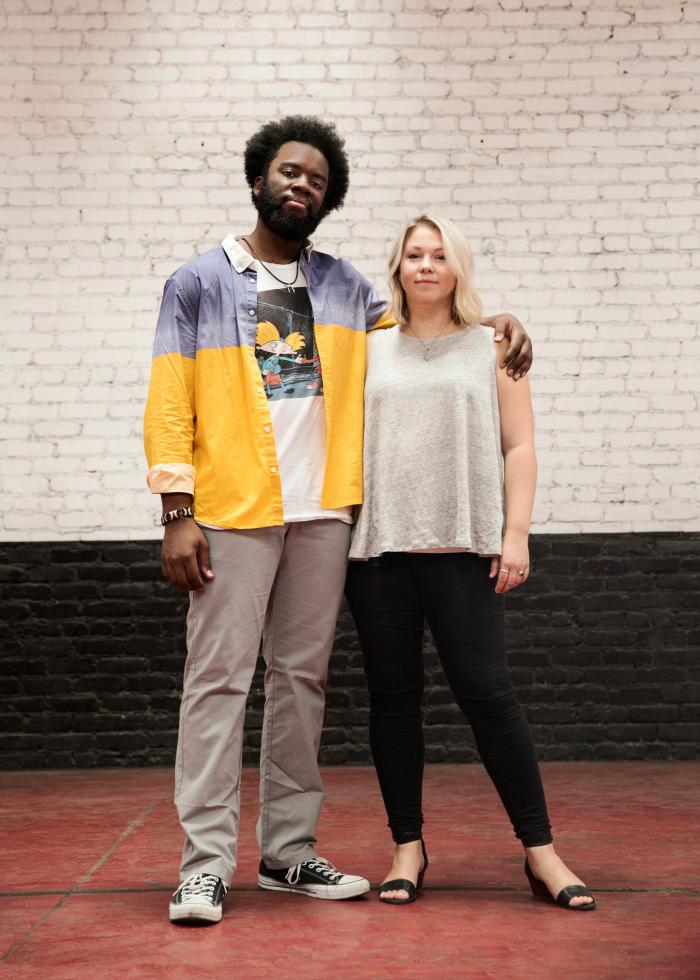
The Musician
Joshua Washington’s band, Current Personae, is more than a band — it’s a community of musicians. The nine-member group is based in Stockton, with additional members throughout the country who join the ensemble when it performs nearby. Each year, Washington hosts a dinner for all of his bandmates in Stockton.
He is soft-spoken and thoughtful with his words. His Facebook feed is filled predominantly with reasons why he loves his city. Washington met Egkan while planning an outdoor concert downtown on the waterfront. He says there was an instant connection, and Egkan helped the group find spaces to hold shows and film music videos.
“He came from San Diego to come here and really learn about the city — not just come in and try to change stuff. He was just as much a Stocktonian as anyone I know,” Washington says. It’s late April, and he is seated at the same orange table that Egkan invented for Huddle. “Meeting Tim, it was like everything just fit. ”
Washington also serves as the director of his family’s music school, Zion Academy of Music, which his father started. The small school provides affordable music lessons to roughly 100 children and teenagers. He says Egkan envisioned students, violins in tow, walking to class in downtown Stockton and was emphatic that Zion Academy join the revitalization efforts.
Washington has lived in Stockton almost his entire life. He has always seen promise in downtown, particularly on the waterfront, and the concerts were part of his desire to help realize this potential. But while his dad always wanted to move the school downtown, Washington says he was indifferent — until he saw downtown through Egkan’s eyes: “Meeting someone as crazy as Tim really inspired me not to let go of that vision.” Together they toured spaces, and Washington developed a sense of urgency to become part of creating a new downtown.
“Tim was a gift to Stockton,” he says, quietly yet emphatically. “We really didn’t deserve him. His influence, even though he wasn’t here very long … his influence will resonate for a while, from all the work he has done.”
Open Window
It’s a very crowded and swamp-warm late February evening inside Stockton City Hall. Many residents are present for public comment on changes made to the city’s water treatment, but at least 100 people stay until nearly midnight to discuss Ten Space’s Open Window project. The development plan, covering almost 12 acres and 51 individual parcels, envisions 1,034 residential units and 400,000 square feet of commercial space. A study from the University of the Pacific’s Center for Business and Policy Research estimates the project will bring in roughly $2 million in additional annual tax revenue for the city as well as create 872 new permanent jobs. Cort, along with COO David Garcia, each take to the podium.
The view of downtown Stockton from the historical Medico-Dental
building, once the tallest building in Stockton and currently
owned by Ten Space.
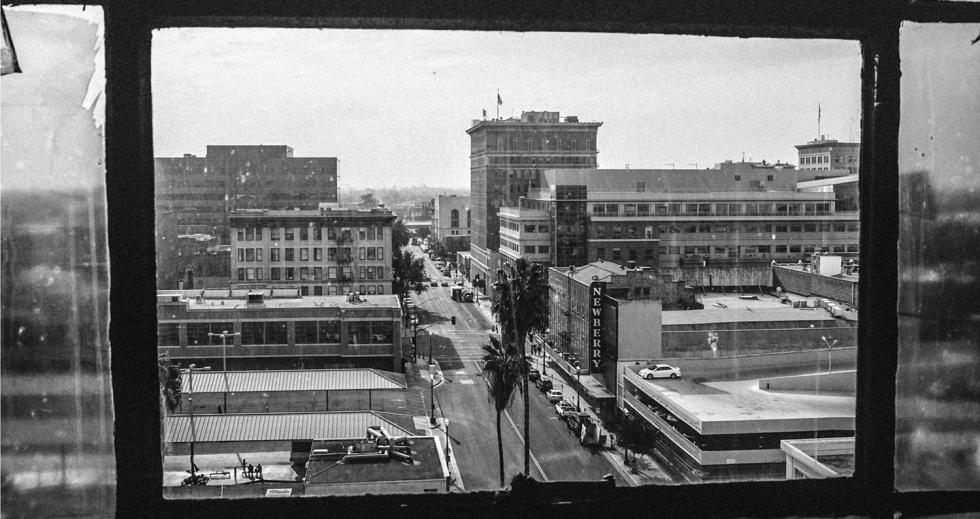
Cort, born in Stockton but raised in the East Bay, began acquiring a significant swath of downtown real estate after the 2008 economic meltdown. His father, Dan Cort, is a prominent developer in both the East Bay and Stockton, and CEO and president of Cort Companies. Garcia grew up on the north side of Stockton before leaving after high school. With a master’s in public policy from Johns Hopkins, he has an analytical mind tuned for navigating policy. While in Maryland, Garcia began chronicling the developments happening in his hometown’s central core through his blog, Stockton City Limits. He started at Ten Space as the community development manager before becoming COO in early 2016.
Later, Garcia and Cort will fondly recall rebranding efforts in their early days as a trio — when Cort attempted to help Garcia, a government guy most comfortable in a suit, and Egkan, a free-spirited surfer, find common ground. “I’m just thinking, ‘This is taking forever; this guy is crazy,” Garcia says. “Just pick a name already!’ But we have a great brand now and a great presence. There was a method to his madness.”
Related: Don’t Count Stockton Out
At the city council meeting, Cort talks about sleeping on an air mattress in every room of the Metro Building — the first he purchased downtown — asking himself each night how to bring people back downtown. Speaking to council members, he references the “incredible personal loss” Ten Space suffered months prior, but it’s Mayor Anthony Silva who finally addresses what many in the room are thinking: “I miss Mr. Egkan, I’m just going to say it,” he says, noting Egkan’s interest in collaborating on possible solutions for downtown’s homeless population. Egkan’s name comes up many times before the vote. The evening runs long, but an overwhelming majority of the public comment is in favor of the project, and it passes — unanimously.
Jeffrey Michael is the director of the Center for Business and Policy Research at the University of the Pacific, and participated in the study done on the Open Window Project. He says that past efforts to revitalize downtown Stockton over the last decade (which included projects like the Stockton Arena and an IMAX theater, both of which required a significant amount of public financing) focused on entertainment options that were “beyond the spending power of the neighborhood they were going into.” Michael feels the Open Window Project’s emphasis on “attracting residents, entrepreneurs and small businesses who will be there making it a 24-hour community,” makes it more viable. “It’s a difficult piece,” he acknowledges, “but it’s more important and ultimately more sustainable.”
The Dancer
Yolanda Amen has saved black and white photos of her parents, aunts and uncles strolling the streets of downtown Stockton — arm-in-arm and dressed in their Sunday best, laughing in mid-conversation or playfully eyeing the camera. She remembers the downtown of her youth as a bustling center for community and commerce, when her mother would take her and her sisters shopping downtown at JC Penny or J.J. Newberry.
“That’s how it was back then, people downtown moving around, all kinds of different cars on the weekends,” says Amen, who graduated from Edison Senior High in 1979. “This really meant something, and I think that it can mean something again.”
Yolanda Amen (fourth from the left) along with family and dancers
at the 2015 Tahiti Fete dance competition in San Jose.
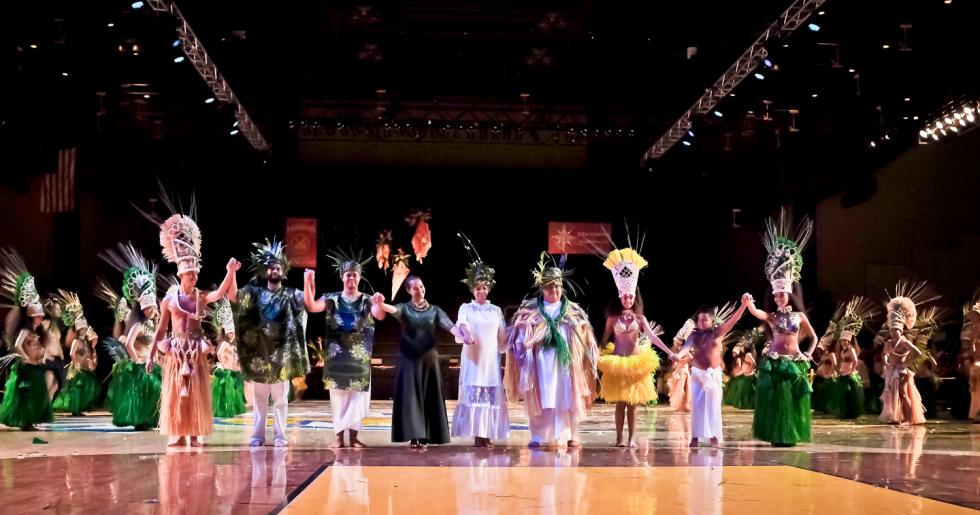
Because of those memories, Amen, who owns and runs a Polynesian dance group called Tamarii Matairea, has always been drawn to downtown. In May 2015, she received notification that her troupe would be kicked out of their rental near the Port of Stockton. The group was preparing for a major dance competition in San Jose that would take place in July — just three days before dancers had to be out of the studio Amen had used for nine years. Egkan caught wind of the dance troupe’s dilemma and called Amen’s daughter, Colie (who is now an executive assistant at Ten Space), and she connected him with her mother. He found the troupe a temporary space, where they moved in August, enabling Amen to continue holding classes while a new, permanent space for Tamarii Matairea is being refurbished.
That’s one of the reasons she chose to stay late at the city council meeting in February, in support of Ten Space. “You’re not going to find anybody more true, and of color, from the south side,” she told the council that evening, referencing the most notoriously underserved part of Stockton. She says she was accused of being the project’s token black voice and wanted to make it clear that she saw the group’s work as both inclusive and beneficial to the community.
“It doesn’t matter if I’m a black woman running a hair salon or if I have a business making bows to put on puppies — I’m still a black businesswoman and I’m a part of this project,” she says, adding that she wants to send a message to anyone who feels excluded to reach out and see for themselves the many opportunities to get involved.
“All of us who live in Stockton — whether south, east, west or north side, where you come from or your income — we need to do what we can to fulfill this legacy for Tim,” she says. “I feel that I am Tim. All of us can be Tim in some way, and that’s how we make his legacy come alive.”
The Artist
Garrett Daniells is standing on the shadeless asphalt outside C.R. Glow Custom Neon, the neon sign shop he and his father own. It’s warm for early June, almost 100 degrees by noon. Daniells is a little rough around the edges. A safety pin dangles from one of his ears, and he doesn’t strike one as the kind of person who would pal around with a commercial real estate developer. But Daniells — who says the city’s vibrant, if underground, arts community is a byproduct of its pain — saw Egkan, in a way, as a fellow artist.
“When you saw Tim in a vacant space, you could see his brain turning,” he says. “This was going to be his creation. Downtown was going to be his art project.”
The two first met at a release party for Placeholder Magazine, a nonprofit arts and culture publication. Daniells recalls Egkan grabbing the mic. “He starts saying like, ‘This [magazine] is what Stockton needs,’ blah blah, ‘We’re going to give you guys a bunch of money, so you can put out your next magazine.’ I remember being kind of put off, like who the f— is this guy? This is my art scene; what does he know?”
Garrett Daniells (24) and Amy Sieffert (33). Daniells says that
while Egkan was connected to people from a wide range of
backgrounds and industries, “he knew his people and his people
were the creatives here.” Sieffert says that “we’re all trying to
figure out how to go forward” since Egkan’s death late last
summer.
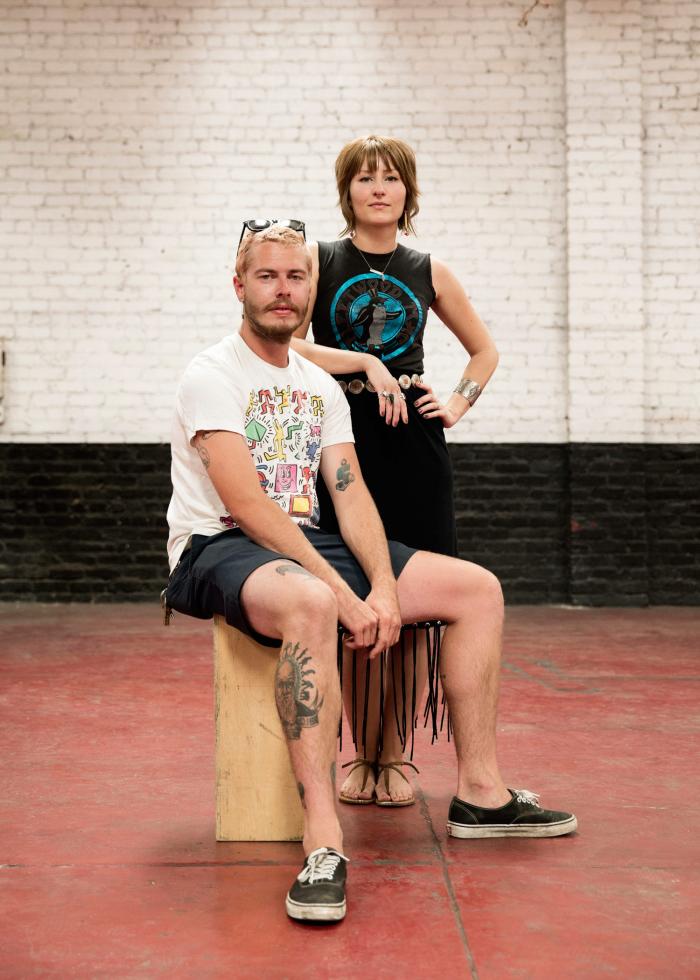
But Egkan won him over. He recruited Daniells to help build out Huddle, and offered him space to create a temporary music venue, the 207, in an empty Ten Space property. Egkan taught him the ins and outs of doing business, Daniells says, how to turn an idea into a proposal, how to execute.
Egkan also provided Daniells with a massive blank canvas. Over a couple of beers, the two began brainstorming a mural project they would go on to call Momentum. Egkan took the idea to Garcia, who started working on the grant. “Tim was really passionate about this project, and I wanted to see it through,” says Garcia, who continued to push forward on the project after Egkan’s death.
But Garcia lacked Egkan’s connection to the local artist community. So Daniells, along with friend and artist Alex Suelto, recruited artists and did the legwork needed to see the project through. Over the course of nine days in April, seven murals went up in the city’s central core.
“A lot of people came up to me, like, ‘You’re really not getting paid to do this?’” Daniells says of Momentum. “I did it because it was my friend’s project. He started a project and it needed to get finished. I finished it.”
Daniells is haunted by the loss of his friend. He says he struggles with anxiety, sleepless nights and drinking too much. For at least one person, the movement that had the community so invigorated has lost some of the authenticity Egkan brought. “He hung out with a bunch of my friends — we got to make art and skateboard and take pictures and make music. It felt, it felt, really organic,” he says, stressing his use of the past tense.
In the next breath, though, he decides he’s being overly critical and declines to elaborate, saying he doesn’t want to sound “pissed off about everything,” and that he has “respect for young guys that got the ability to put some money together to try to revitalize an area. More power to them.”
Stockmarket aims to offer small local businesses a new way to
engage with customers. It’s grown consistantly since it launched
in spring of 2015.
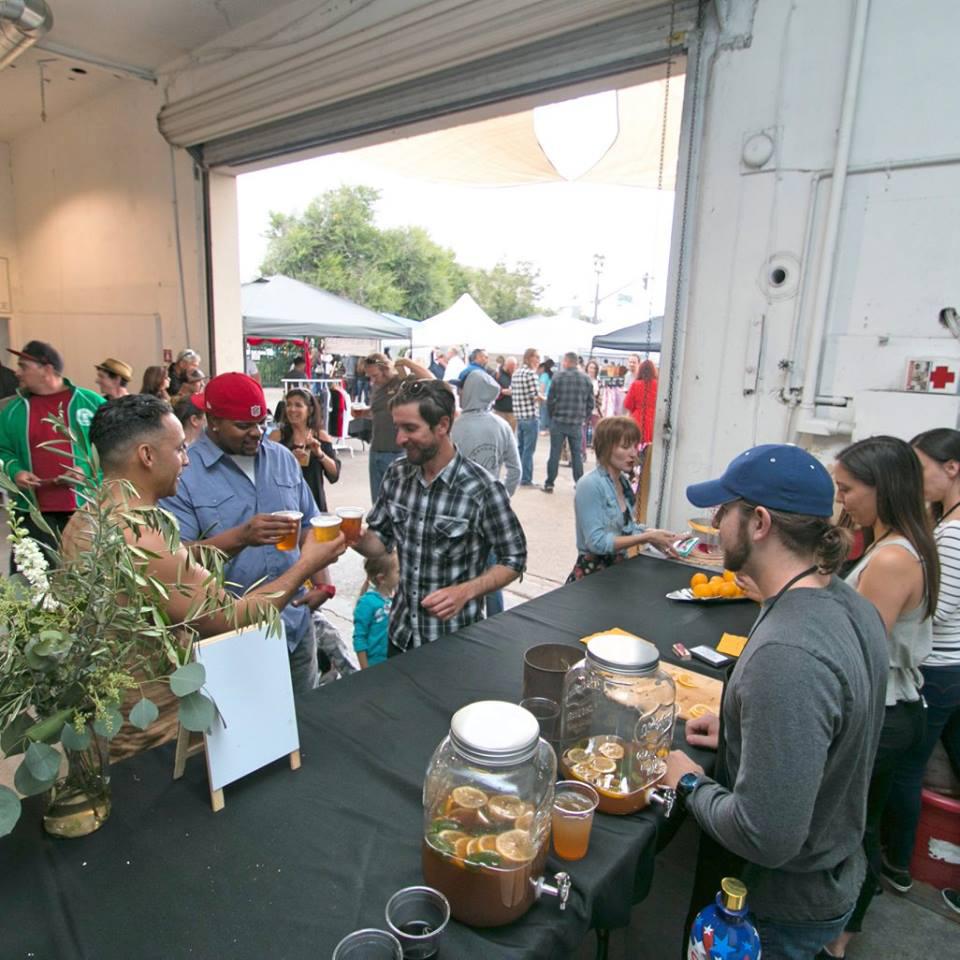
The Merchant
Amy Sieffert, cofounder of Stockmarket, nibbles on a chocolate cookie in an alleyway off of El Dorado Street, Trail Coffee Roasters’ outdoor patio. She’s coming off of a busy weekend in April: The first market of the year, held the previous Saturday, featured 70 vendors and saw roughly 2,000 attendees. Patrons of Trail congratulate her as they pass through.
“One of the issues Stockton has had is a lot of people have been disconnected,” she says. “There’s a lot of cool stuff happening and talented people, but it’s about getting us all together.” Sieffert cofounded Stockmarket along with Macrae, and she too met Egkan at Huddle. She says initially she was taken aback by his “huge personality,” describing him as “brash” but “not in a bad way.” But by the end of their first meeting, he had sold her on his vision for a new downtown. “It’s like there’s all these lines and dots, and no one knew how to connect them — but he saw how,” she says.
Sieffert, who ran an online business selling vintage clothing, opened a temporary pop-up shop at Huddle in August of 2014 — rent-free, because Egkan felt she could help showcase the space’s potential. After a two-week stint, she approached Egkan with an idea: She wanted to put together a curated makers market in Stockton. He offered her space in the Newberry Building, which was under construction at the time. Egkan, Macrae, Sieffert and a handful of their friends hosted an initial test market that December. When Sieffert and Macrae decided to expand the market, Egkan helped them move into a bigger space. The group spent months pulling up rotted carpet, knocking down walls and painting the abandoned location on Weber Street. Stockmarket officially launched in May 2015. The new location’s outdoor lot enabled more vendors, food trucks and live music.
“He saw the potential and importance of individuals. He understood that without people, those buildings are just empty spaces.”Amy Sieffert, founder, Stockmarket
Since then, a number of the market’s vendors have moved into brick-and-mortar spaces. The Natural ‘Do hair salon, Macaronage & Confections bakery — and soon, the Cast Iron Trading Co. cafe — either do or will reside in downtown Stockton and in Ten Space buildings. Sieffert says none of these successes would have been possible without Egkan.
“He saw the potential and importance of individuals,” she says. “He understood that without people, those buildings are just empty spaces.”
Filled Spaces
The first phase of the Open Window Project is under way, including just over 200 residential units — lofts, apartments and townhomes — mostly market-rate, but roughly one-quarter of which Ten Space intends to make affordable housing, according to Garcia. The historic Sutter Manor hotel will be refurbished as a mixed-use residential and retail space. Amen’s Tamarii Matairea dance troupe will be among its first tenants. The historic Newberry Building has been completely rehabilitated and is now fully occupied. Garcia says half of the first phase’s 60,000 square feet of commercial space is pre-leased.
Huddle has outgrown its space on San Joaquin Street and will move into the nearby Belding Building, almost tripling its space to three floors and 13,500 square feet. Ten Space will also move into the Belding Building. Channel Brewing, a local brewery, will join Cast Iron Trading Co. on the ground floor. With Ten Space leaving their current home at the Metro Building, the San Joaquin Pride Center is able to expand to a second floor. Road Finch, a marketing company and Huddle graduate, will join it. The abandoned Ambassador Hotel, a couple blocks over, has been torn down and a new home for Reality Church Stockton will take its place.
Others have moved forward in their own ways. Leek stepped down as Huddle’s executive director in May to start a new project, dubbed Third City Coalition: a “new-age think tank interested in improving community development and civic engagement,” she says. Washington hasn’t yet chosen a spot for his family’s music school and is still touring spaces, but says he hopes to make a move sometime this fall. Staying in Stockton proved too difficult for Egkan’s widow, Macrae, who moved to midtown Sacramento early this year — though she still returns on a regular basis and helps with Stockmarket when she can. The market has grown into a monthly event that runs from April to December, though Sieffert says that now, without Egkan, Stockmarket’s relationship with Ten Space has changed “to strictly that of landlord and tenant.” It’s strictly business for Daniells as well: He and his father occasionally work with Ten Space to provide signage for incoming tenants, but he says his artistic endeavors haven’t dovetailed with a Ten Space project since Egkan’s death, save for Momentum.
Tim Egkan (left) and David Garcia (right) in downtown Stockton in
January 2015.
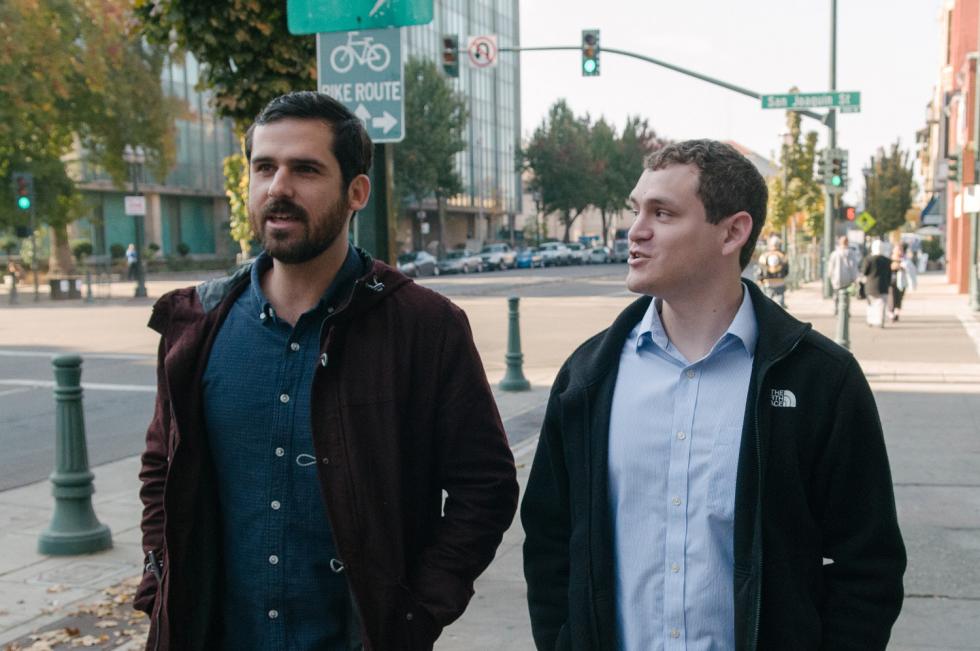
For his part, Garcia says he isn’t interested in recruiting “liquor stores to pay $3 per square foot,” and is committed to finding strong tenants that will contribute to Ten Space’s broader mission.
“We never want to forget where we came from, and how much sacrifice we put into this movement,” he says. “To me, that means never settling, and always staying humble and grateful for this opportunity that was largely put into motion by Tim’s relentless energy and vision for a city that he didn’t have to love.”
To this day, Garcia says, “when I hear keys, for a brief moment I think Tim is going to walk past my office.”
Artist Alex Suelto’s mural, outside of the old Huddle offices,
calls to passersby: “Live life like Tim.”

Recommended For You
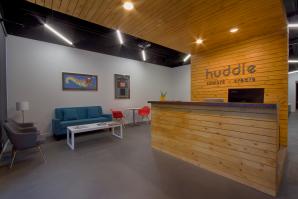
Stockton Cooperation
Huddle hopes to foster more than coworking in downtown Stockton
David Garcia, Stockton born and bred, has a background in urban policy and planning and has called cities like Baltimore and Washington, D.C., home. So when he and Tim Egkan co-founded Huddle, a new coworking space in downtown Stockton that held its soft opening last June, he knew change was possible. But that doesn’t mean he thinks it will be easy.

Stockmarket Goes Up in Forlorn Downtown Stockton
New market seeks to revitalize area by showcasing local artisans
Amy Sieffert, a Stockton native, has been running a vintage clothing business since 2010 — but she had to leave her hometown to make a profit. On weekends, she would travel to Sacramento and the Bay Area because there were no local makers markets where she lived. To help turn this ghost town into a local hotspot, Sieffert and business partner Katie Macrae created the Stockmarket, a seasonal market that showcases Central Valley artisans.



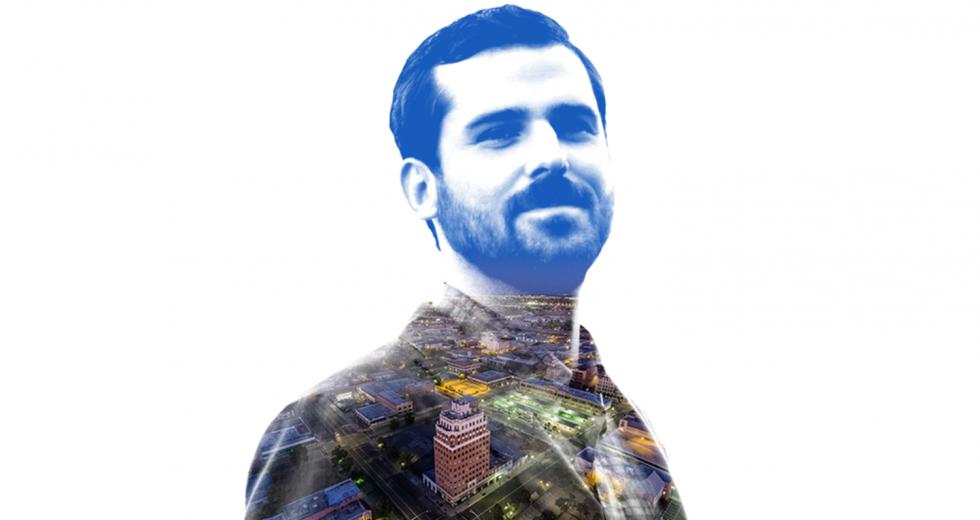

Comments
That was a great article . I never met Tim. But I know of him through my kid Jasper. Who did get to meet him. And know numerous people in this article. Keep his vision going.✌✌
This article is a great insight into all of the revitalization going on in Stockton. Thank you for mentioning so many people who are the movers and shakers of this ongoing process. I hope everyone shares this article/the information in it with people they know all over Stockton and NorCal. There are people in this city who have lost hope for the community and do not know about the great improvement strategies and opportunities rising from the ashes. There are also many college students in this town looking to do positive things with their knowledge and experience - but they do not know about potential/opportunities in Stockton after graduation. Let's spread the word.
This article is a great insight into all of the revitalization going on in Stockton. Thank you for mentioning so many people who are the movers and shakers of this ongoing process. I hope everyone shares this article/the information in it with people they know all over Stockton and NorCal. There are people in this city who have lost hope for the community and do not know about the great improvement strategies and opportunities rising from the ashes. There are also many college students in this town looking to do positive things with their knowledge and experience - but they do not know about potential/opportunities in Stockton after graduation. Let's spread the word.